David's Astronomy Pages
CCD Images - Session 1084 (2023-01-09)
Images
(S1083)
Images
Main
Home
Page
Images
(S1085)
David's Astronomy Pages
|
Images (S1083) |
Images Main |
Home Page |
Images (S1085) |
Objects Session Notes
HAT-P-3 - Exoplanet Transit HAT-P-3b (Attempted Observation) AT 2022emb - CV Type Transient AT 2023ds - CV Type Transient IC 1756 - Spiral Galaxy with Type Ia Supernova 2023Q M31 - Spiral Galaxy with Transient AT 2023U M33 2022-11a? - Candidate Extragalactic Nova in M33 NGC 7769 - Spiral Galaxy with Supernova 2022aedu - NGC 1300 w/SN & UGC 2926 w/SN attempts failed (due to cloud) Variable Stars (photometric monitoring) - SS Cyg, BL Lac Nearby Stars (astrometric monitoring) - 61 Cyg
- All night session (7.5 hour),but determinated earlier due to cloud - 12" LX200 + ST-10XME for imaging - TS 80mm APO + ZWO ASI178MC for guiding & imaging - Ambient Temperature: 0.5°C (min) - CCD Temperature: -25°C - Notes from 2023-01-09 >> [ Local Files >> ]
| HAT-P-3 (Ursa Major)
HAT-P-3 (Alias GSC 3466:819) is host star to exoplanet HAT-P-3b ( Exoplanet Host Stars ) |
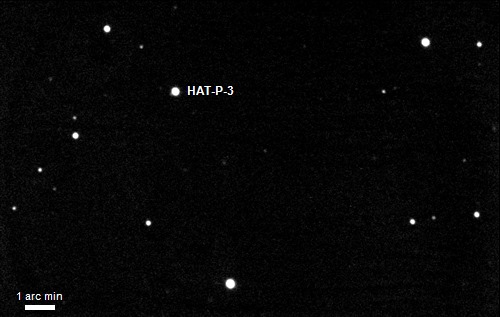 |
| Annotated CCD Image (70% size, linear scale) 5 x 30s exposure (average combine), 3x3 binning, Xo Filter 2023-01-09 20:26 UT (#1084066-70) 12" LX200R (at f/10.4) + ST-10XME Auto-guided using TS 80mm APO, ZWO ASI178MC & PHD2 |
| HAT-P-3b Transit Forecast Forecast from ExoWorldsSpies Scheduler (https://www.exoworldsspies.com/en/scheduler/) |
 |
| Moon Info Average Phase 92%, Altitude climbing from 20° to 45° |
| HAT-P-3 Star Field Info Altitude climbing from 18°at start of run to 38° at end Average Separation from Moon 56.5° |
| Autoguiding Auto guiding within images was relatively good with Av RMS Error of 1.8" (RA 1.1", Dec 1.4") across 381 frames However automated Lock Adjustments were made between 94 frames and a bias in this allowed stars to drift gradually southwards through the course of the run, which meant that stars didn't remain fixed throughout the run, which is not ideal. Manual interventations to try to returns stars to/towards their starting positions were only partially successful Pictures below illustrate the guiding performance across i) the first 12 frames and ii) across all frames Note how the Guide Star shows a pretty consistent S/N. |
 |
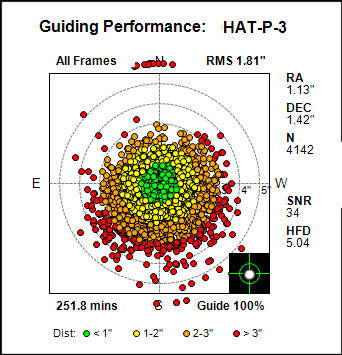 |
| Image Reduction Images were acquired with the ST-10XME CCD operating at a temperture of -25°C, and were reduced with Master Dark Frame for 25°C of the same exposure time (30s) Images were reduced with Master Light Frame for the same filter Xo created earlier using the same equipment setup. Despite the moon at (92% phase at separation angle of 56°) the reduced images and seem fairly flat with no obvious gradients evident. The following pictures show Raw File, Master Dark Frame, Master Flat Frame and the results Reduced Frame 5 x 30s exposure (average combine), 3x3 binning, Xo Filter, #1084066, 50% size Whilst the Master Flat may/may not have its deficiencies, there is no signature of it showing through to the reduced frame, showing that it has basically done a good job. |
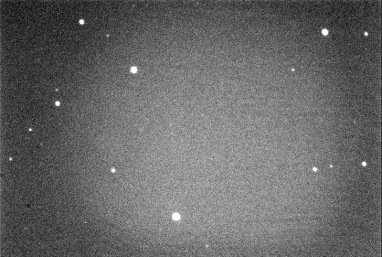 |
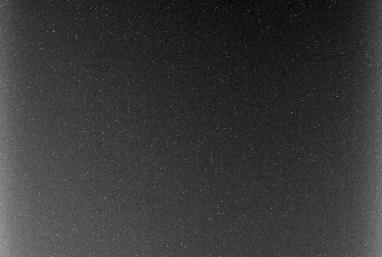 |
 |
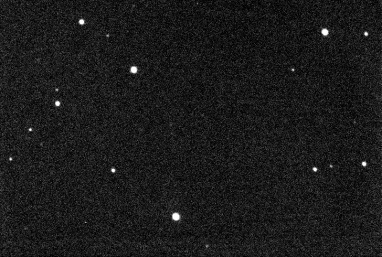 |
| Moving Object Check 378 images aligned and stacked. No trailed (moving) objects are evident |
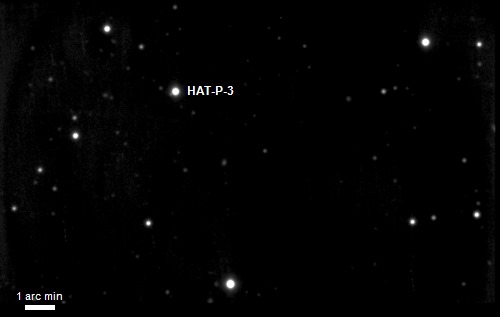 |
| Annotated CCD Image (70% size, square root scale) 378 x 30s exposure (average combine), 3x3 binning, Xo Filter 2023-01-09 22:29 UT (#1084066-446) 12" LX200R (at f/10.4) + ST-10XME Auto-guided using TS 80mm APO, ZWO ASI178MC & PHD2 |
|
Reference Stars For the time being a single calibration star is used for Photometry (There are potential options for running the photometry with 2 or 3 calibration stars for greater accuracy) Variable Star (V) - HAT-P-3 (GSC 3466:819, catalog mag 11.4) Calibration Star (C) - GSC 3466:1158 (catalog mag 10.88) Check Star (K) - GSC 3466:1145 (catalog mag 11.8) (Details loaded to Analysis/Reference/ProjectStars.txt) |
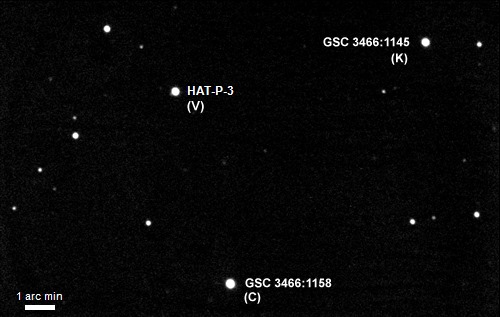 |
| Annotated CCD Image (70% size, linear scale) 5 x 30s exposure (average combine), 3x3 binning, Xo Filter 2023-01-09 20:26 UT (#1084066-70) 12" LX200R (at f/10.4) + ST-10XME Auto-guided using TS 80mm APO, ZWO ASI178MC & PHD2 |
| Graph of Instrumental Magnitudes Sky transparency variations are clearly evident in the plot of (raw) instrumental magnitudes. Calibration Star shows instrumental magnitude variations of around +/- 0.15 mag , then add in transparency variations across the field of view and it is easy to see that the conditions were basically not fit enough on the night for trying to detect the exoplanet transit with depth of only 0.014 mag. |
 |
| Graph of Relative Magnitudes The aim was to detect a transit with a depth of 0.014 mag, that was forecast to happen between 21:30 and 23:35 UT . Unfortunately the scatter is in the order of +/- 0.020 mag which lies on top of a long wavelength variation of 0.040 mag. The graph of Check (K) Star should be flat with little scatter but clearly it's not. A significant amount of scatter is still present when taking a 5 minute moving average (average magnitude for 7 points). Although there was no obvious passing cloud there was probably enough thin cloud or haze that was lit by the near full moon that introduced so much background sky noise that it hids evidence of the transit .(There might be a hint of the transit starting at around 21:50 UT but the confidence in this is low) |
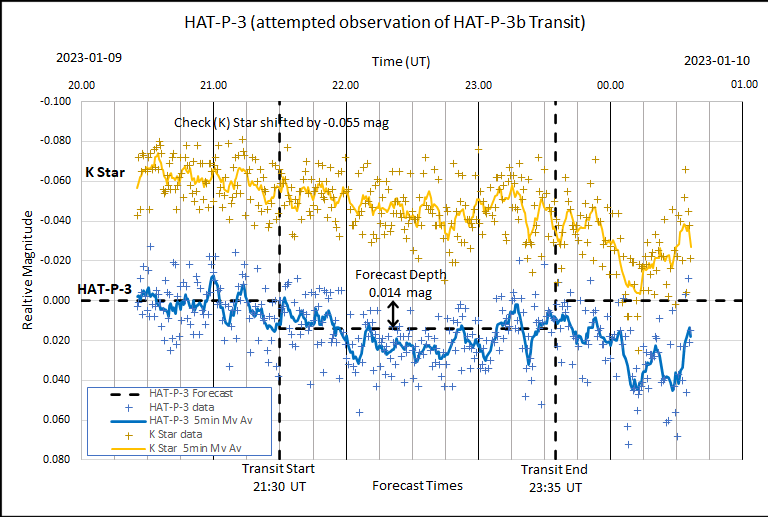 |
| AllSky Image at time of Mid Transit. Ignoring the artefacts that are associated with moonlight hitting the AllSky Camera hemisphere & fish eye lens, the sky appears to be pretty clear of cloud, however it does seem slightly hazy and there is evidence of thin cloud at low altitude on the opposite side of the sky (ie in the SW Sky ) |
 |
| Further Analysis The following pictures show contour displays for the first 3 frames of the run (taken 35s apart), with lines delineating percentage changes in light fall off Whilst these display would normally be used to determine how much vignetting is present in the system, in this case they illustrate the rapid changes in sky background brightness. This will add uncertainty to photometric analysis and if also respresents variations in sky transparency it will add yet further uncertainty to the photometric analysis. All 3 frames were reduced using the same Master Flat Frame (Xo Filter, see bottom picture). There is no there is no signature of Master Flat deficiency carrying through to reduced images Problem appears to be due entirely to unstable Sky Condition |
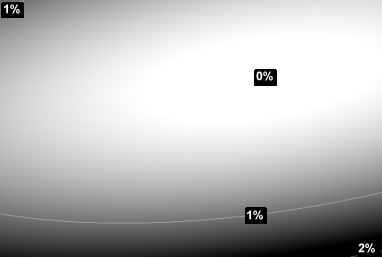 |
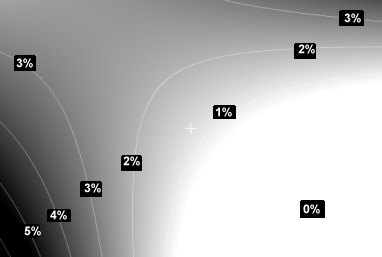 |
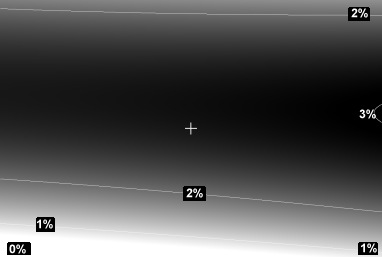 |
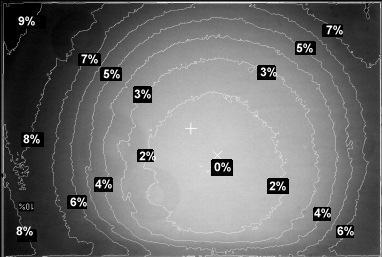 |
| Result & Lessons Although the attempted observation of the transit exoplanet HAT-P-3b was unsuccessful the exercise was neverthess useful and produced quite a few insights and ways to optimise procedures moving forward. A key lesson is to make exoplanet transit on a night when the moon not in the sky or is much less bright Ideally the sky should be free of any cloud / haze, however thin. |
Back to Top
| AT 2022emb (Cygnus) AT 2022emb (Type: CV) discovered 2022-03-06.473 UT by Kumar Alias: GEOTS-2022-005 Discovery Mag 14.3 (Clear filter) ( TNS 2022emb ) |
| AT 2022emb - 2023-01-09 (T+309.3d) Image below (2023-01-09.786) was taken 309.3 days after discovery of 2022emb Position of reported SN (faint) is shown by white cross-hairs Measured magnitide +15.76 |
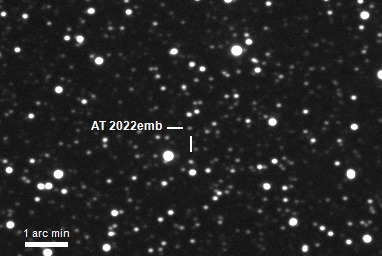 |
| Annotated CCD Image (100% size, linear scale, cropped) 5 x 60s exposure (average combine), 3x3 binning, Clear Filter 2023-01-09 18:55 UT (#1084023-27) 12" LX200R (at f/10.4) + ST-10XME Auto-guided using TS 80mm APO, ZWO ASI178MC & PHD2 |
| Images of SN 2023Q (IC 1756) on Supernova 2023 Page >> |
Back to Top
| AT 2023ds (Cygnus) AT 2023ds (Type: CV) discovered 2023-01-08.458 UT by Gaia Alias: Gaia23ady Discovery Mag 13.63 (G-Gaia Filter) vs Historic magnitude 13.84 Galactic plane star brightens by 0.25 mag, previous event seen ( TNS 2023ds | Gaia23ady ) |
| AT 2023ds - 2023-01-09 (T+1.3d) Image below (2023-01-09.799) was taken 1.3 days after discovery of 2023ds Position of reported transient (distinct) is shown by white cross-hairs Measured magnitude +13.62 |
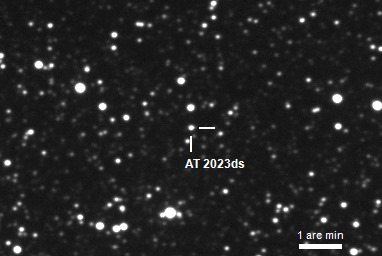 |
| Annotated CCD Image (100% size, linear scale, cropped) 5 x 60s exposure (average combine), 3x3 binning, Clear Filter 2023-01-09 19:14 UT (#1084039-43) 12" LX200R (at f/10.4) + ST-10XME Auto-guided using TS 80mm APO, ZWO ASI178MC & PHD2 |
| Images of AT 2023ds on Transients 2023 Page >> |
Back to Top
| IC 1756 with SN 2023Q (Cetus) SN 2023Q (Type: Ia, z= 0.022) discovered 2023-01-03.082 UT by ATLAS Alias: ATLAS23adv, ZTF23aaaahln Discovery Mag 17.51 (orange-ATLAS filter) ( Rochester Supernova site | TNS 2023Q ) |
| IC 1756 with SN 2023Q - 2023-01-09 (T+6.7d) Image below (2023-01-09.758) was taken 6.7 days after discovery of 2023Q Position of reported SN (distinct) is shown by white cross-hairs |
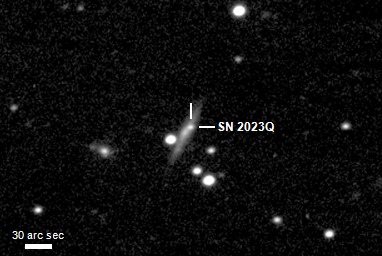 |
| Annotated CCD Image (125% size, square root scale, cropped) 4 x 180s exposure (average combine), 3x3 binning, Clear Filter 2023-01-09 18:22 UT (#1084005-09) 12" LX200R (at f/10.4) + ST-10XME Auto-guided using TS 80mm APO, ZWO ASI178MC & PHD2 |
| Images of SN 2023Q (IC 1756) on Supernova 2023 Page >> |
Back to Top
| M31 with AT 2023U (Andromeda) AT 2023U (Type: unk) discovered 2023-01-03.576 UT by XOSS Alias: XM93MZ, PNV J00423797+4117130, M31N 2023-01a Discovery Mag 18 ( Rochester Latest Extragalactic Novae | TNS 2023U ) |
| M31 with AT 2023U - 2023-01-10 (T+6.5d) Image below (2023-01-10.028) was taken 6.5 days after discovery of 2023U Reported position of transient (not visible) is shown by white circle |
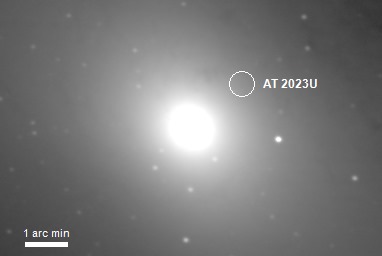 |
| Annotated CCD Image (100% size, square root scale, cropped) 5 x 180s exposure (average combine), 3x3 binning, Clear Filter 2023-01-10 00:49 UT (#1084449-53) 12" LX200R (at f/10.4) + ST-10XME Auto-guided using TS 80mm APO, ZWO ASI178MC & PHD2 |
| Images of AT 2023U (M31) on Transients 2023 Page >> |
Back to Top
| M33 with Candidate Nova M33 2022-11a? (Triangulum) Nova M33 2022-11a? (Type: unk) discovered 2022-11-20.575 UT by XOSS Alias: TCP J01350893+3031503 Discovery Mag +13.4 ( Rochester Latest Extragalactic Novae | TCP J01350893+3031503 | Discovery Image ) |
| Nova M33 2022-11a? - 2023-01-10 (T+50.5d) Image below (2023-01-10.042) was taken 50.5 days after discovery of Nova M33 2022-11a? Position of reported nova (distinct) is shown by white cross-hairs Measured magnitude +15.62 Poor quality image (clouds developing, 2 frames only) |
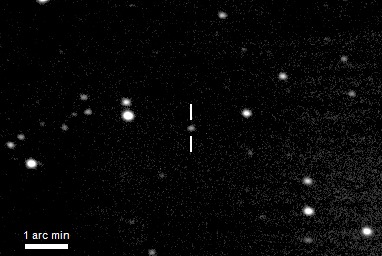 |
| Annotated CCD Image (100% size, square root scale, cropped) 2 x 180s exposure (average combine), 3x3 binning, Clear Filter 2023-01-10 01:03 UT (#1084456-57) 12" LX200R (at f/10.4) + ST-10XME Auto-guided using TS 80mm APO, ZWO ASI178MC & PHD2 |
| Images of Nova M33 2022-11a? (M33) on Transients 2022 Page >> |
Back to Top
| NGC 7769 with SN 2022aedu (Pegasus) 2022aedu (Type: SN) discovered 2022-12-31.384 UT by Koichi Itagaki Discovery Mag +16.9 (Clear Filter) ( TNS 2022aedu ) |
| NGC 7769 with SN 2022aedu - 2023-01-09 (T+9.4d) Image below (2023-01-09.814) was taken 9.4 days after discovery of 2022aedu Position of reported supernova (faint) is shown by white cross-hairs Estimated Magnitude +15.9 (by comparison) |
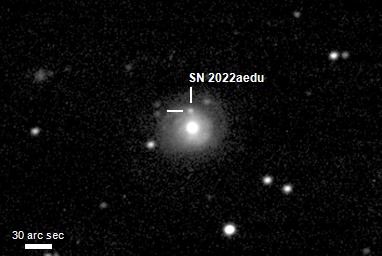 |
| Annotated CCD Image (125% size, square root scale, cropped) 3 x 180s exposure (average combine), 3x3 binning, Clear Filter 2023-01-09 19:39 UT (#1084051-55) 12" LX200R (at f/10.4) + ST-10XME Auto-guided using TS 80mm APO, ZWO ASI178MC & PHD2 |
| Images of SN 2022aedu (NGC 7769) on Supernova 2022 Page >> |
Back to Top
| This Web Page: | CCD Images - Session 1084 (2022-01-09) |
| Last Updated : | 2023-11-24 |
| Site Owner : | David Richards |
| Home Page : | David's Astronomy Web Site |